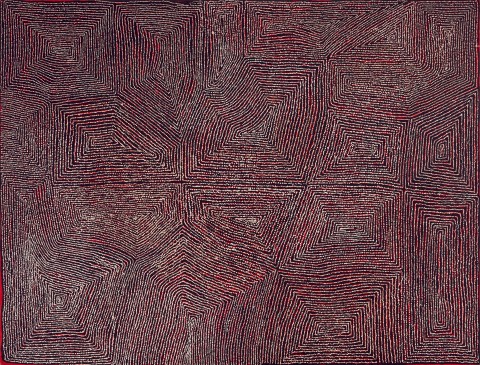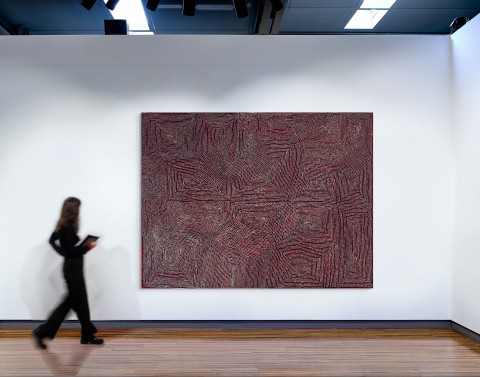UNTITLED, 2004
GEORGE WARD TJUNGURRAYI
synthetic polymer paint on linen
183.0 x 244.0 cm
bears inscription verso: artist's name, size and Papunya Tula Artists cat. GW0404200
Papunya Tula Artists, Alice Springs, Northern Territory
Palya Art, Darwin
Private collection, Adelaide, acquired from the above in 2005
When George Ward Tjungurrayi won the prestigious Wynne Prize for landscape painting at the Art Gallery of New South Wales in 2004, he was at the time only the second Indigenous artist to be awarded that honour. Born in the desert in Western Australia, he is the half-brother of renown painters, Yala Yala Gibbs Tjungurrayi and Willy Tjungurrayi. Relocated with his family to the Papunya settlement by the Northern Territory Welfare Branch in the 1960s, Geroge Ward worked as a butcher and fencer. Moving in the 1980s to Kiwirrkura, deep in Pintupi territory, inspired him to begin painting. His first exhibition was held in 1990, and his work has since been shown in group and solo shows throughout Australia and around the world.
The Pintupi had a profound influence on the emergence of Western Desert art in Papunya from the early 1970s, with artists such as his half-brother Yala Yala Gibbs Tjungurrayi, together with Ronnie Tjampitjinpa, Uta Uta Tjangala and Antatjari Tjakamarra, rendering on board and canvas sacred accounts of the Tingari ancestors’ mythological creation stories and their effect on the natural landscape. Their success and resultant advocacy for their people’s return to country lead to the establishment of the homeland settlements of Kintore and Kiwirrkura in the 1980s. Originally adapted from and reflecting the potency of ritual sand drawings and incised objects, the paintings of Western desert artist evolved over decades to become an internationally recognised contemporary art movement.
A captivating work, Untitled, 2004 is a fine example of the artist’s designs and mesmerising compositions – featuring compressed and expanding Tingari square designs of fine meandering black lines and shimmering stippled white dots on an ochre ground. Most likely depicting the site of Karrkurritinytja (Lake MacDonald), Untitled tells of the travels of the Tingari, as they moved across the landscape performing rituals and creating particular sites. On the most literal interpretation, like many other Western Desert paintings, this work can be read as a ‘map’, a topographical aerial view of ancestral lands combined with a codified mnemonic system of symbols conveying tjukurrpa and ceremonies associated with this site.
CRISPIN GUTTERIDGE

